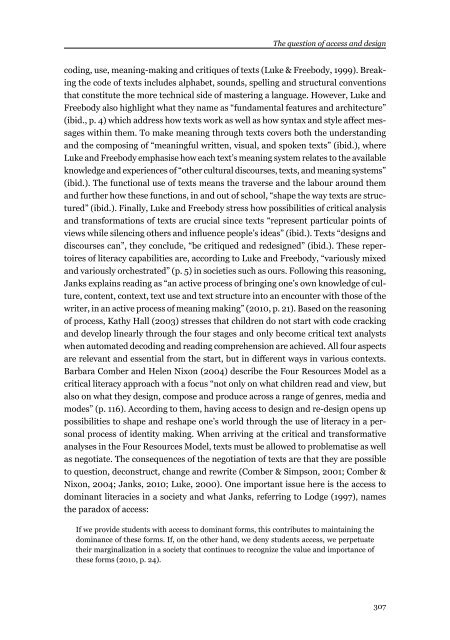Download issue - Umeå universitet
Download issue - Umeå universitet
Download issue - Umeå universitet
Create successful ePaper yourself
Turn your PDF publications into a flip-book with our unique Google optimized e-Paper software.
The question of access and design<br />
coding, use, meaning-making and critiques of texts (Luke & Freebody, 1999). Breaking<br />
the code of texts includes alphabet, sounds, spelling and structural conventions<br />
that constitute the more technical side of mastering a language. However, Luke and<br />
Freebody also highlight what they name as “fundamental features and architecture”<br />
(ibid., p. 4) which address how texts work as well as how syntax and style affect messages<br />
within them. To make meaning through texts covers both the understanding<br />
and the composing of “meaningful written, visual, and spoken texts” (ibid.), where<br />
Luke and Freebody emphasise how each text’s meaning system relates to the available<br />
knowledge and experiences of “other cultural discourses, texts, and meaning systems”<br />
(ibid.). The functional use of texts means the traverse and the labour around them<br />
and further how these functions, in and out of school, “shape the way texts are structured”<br />
(ibid.). Finally, Luke and Freebody stress how possibilities of critical analysis<br />
and transformations of texts are crucial since texts “represent particular points of<br />
views while silencing others and influence people’s ideas” (ibid.). Texts “designs and<br />
discourses can”, they conclude, “be critiqued and redesigned” (ibid.). These repertoires<br />
of literacy capabilities are, according to Luke and Freebody, “variously mixed<br />
and variously orchestrated” (p. 5) in societies such as ours. Following this reasoning,<br />
Janks explains reading as “an active process of bringing one’s own knowledge of culture,<br />
content, context, text use and text structure into an encounter with those of the<br />
writer, in an active process of meaning making” (2010, p. 21). Based on the reasoning<br />
of process, Kathy Hall (2003) stresses that children do not start with code cracking<br />
and develop linearly through the four stages and only become critical text analysts<br />
when automated decoding and reading comprehension are achieved. All four aspects<br />
are relevant and essential from the start, but in different ways in various contexts.<br />
Barbara Comber and Helen Nixon (2004) describe the Four Resources Model as a<br />
critical literacy approach with a focus “not only on what children read and view, but<br />
also on what they design, compose and produce across a range of genres, media and<br />
modes” (p. 116). According to them, having access to design and re-design opens up<br />
possibilities to shape and reshape one’s world through the use of literacy in a personal<br />
process of identity making. When arriving at the critical and transformative<br />
analyses in the Four Resources Model, texts must be allowed to problematise as well<br />
as negotiate. The consequences of the negotiation of texts are that they are possible<br />
to question, deconstruct, change and rewrite (Comber & Simpson, 2001; Comber &<br />
Nixon, 2004; Janks, 2010; Luke, 2000). One important <strong>issue</strong> here is the access to<br />
dominant literacies in a society and what Janks, referring to Lodge (1997), names<br />
the paradox of access:<br />
If we provide students with access to dominant forms, this contributes to maintaining the<br />
dominance of these forms. If, on the other hand, we deny students access, we perpetuate<br />
their marginalization in a society that continues to recognize the value and importance of<br />
these forms (2010, p. 24).<br />
307

















